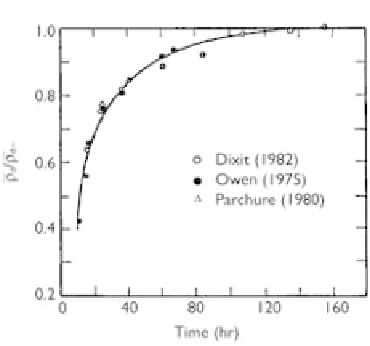Geoscience Reference
In-Depth Information
The three distinct stages of consolidation were also observed in Nedeco's (1965)
experiments on the consolidation process of natural mud from Bangkok Bar Channel
in saline water. The mud surface sank linearly with time
t
in the initial stage, with
t
0.5
in the second stage, and with log(
t
) in the third stage. Several initial suspension
heights and wet sediment densities were tested. It was found that the mud with low
initial density gradually tended to attain the same density as the sample with high initial
density, and the wet sediment density increased toward the bottom of the cylinder,
due to larger pressure in the deeper layer.
The degree of consolidation depends on sediment size, mineralogical composi-
tion, deposit layer thickness, etc. According to van Rijn's (1989) experiments on
the consolidation process in a layer of pure kaolinite material in saline water, a thin
layer of mud consolidates faster than a thick layer with the same initial concentration
because in the latter case the pore water has a larger travel distance to the mud surface.
Variation of bed density
As experimentally observed by Owen (1975), Dixit (1982), and Hayter (1983), the
dry bed density varies along the depth below the bed surface. The general trend can
be approximated by (Hayter, 1983)
a
H
m
ρ
d
ρ
d
=
−
z
(11.22)
H
where
d
is the mean dry density of bed,
H
is the bed
thickness,
z
is the depth below the bed surface, and
a
and
m
are coefficients dependent
on soil properties and consolidation time.
Fig. 11.9 shows the mean dry bed density varying with consolidation time for
the Avonmouth mud (Owen, 1975), commercial grade kaolinite in salt water
(salinity
ρ
d
is the dry density of bed,
ρ
=
35 ppt) (Parchure, 1980), and kaolinite in tap water (no salinity) (Dixit,
Figure 11.9
Variation of mean bed density with consolidation time (Dixit, 1982).


